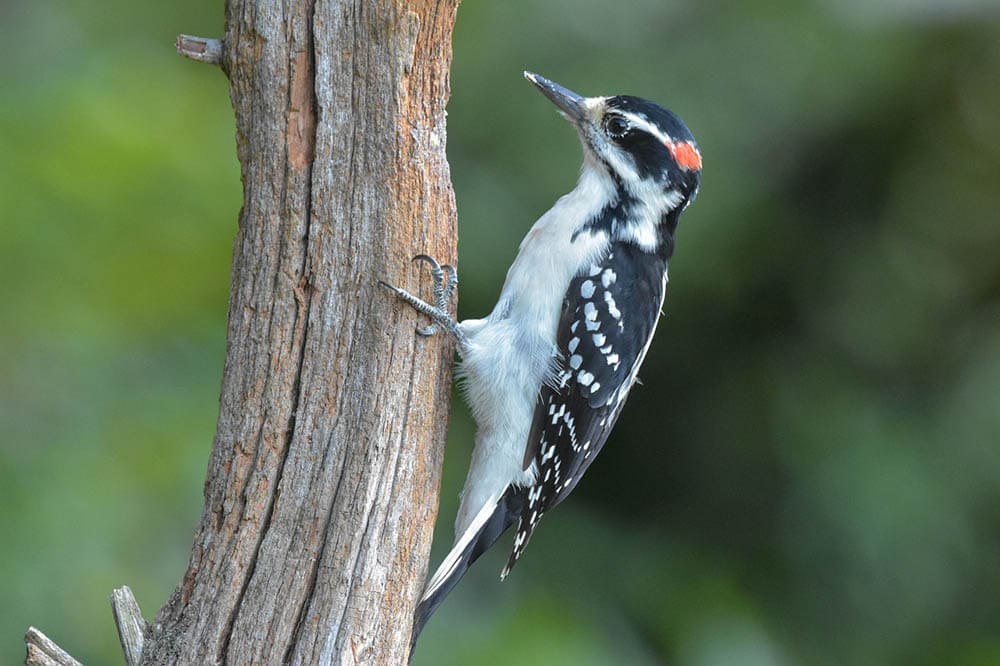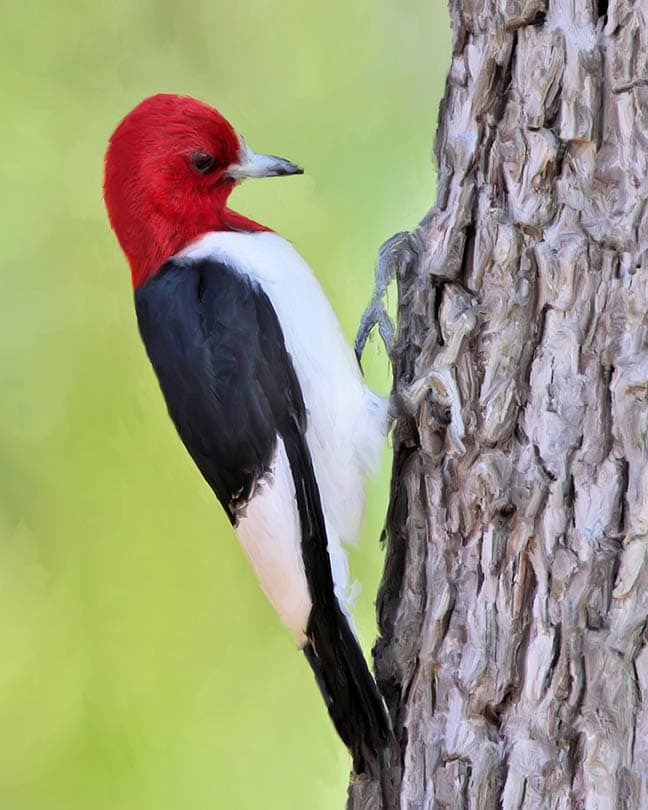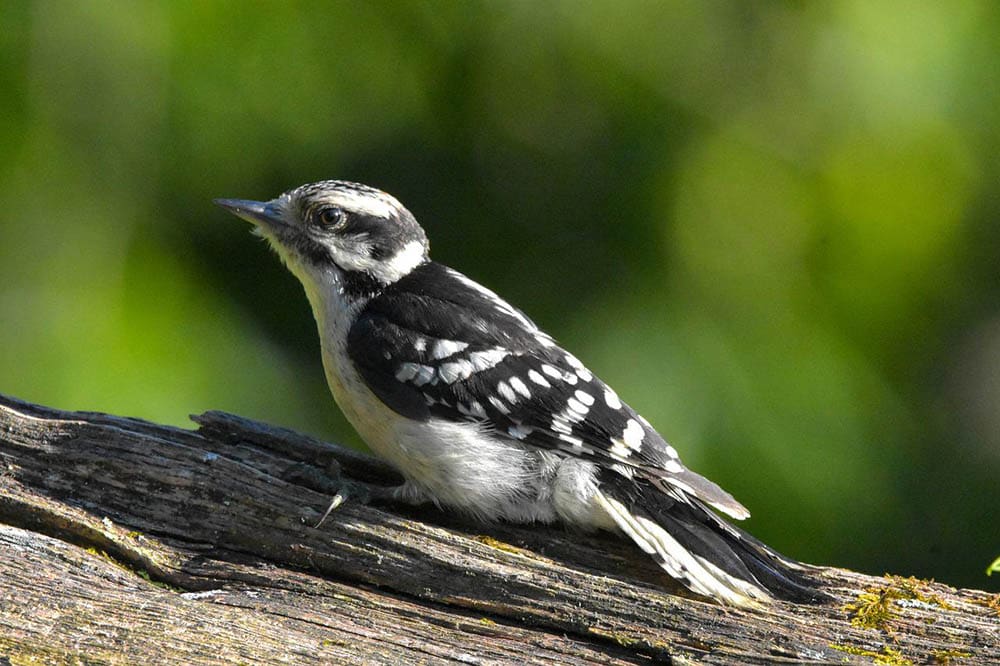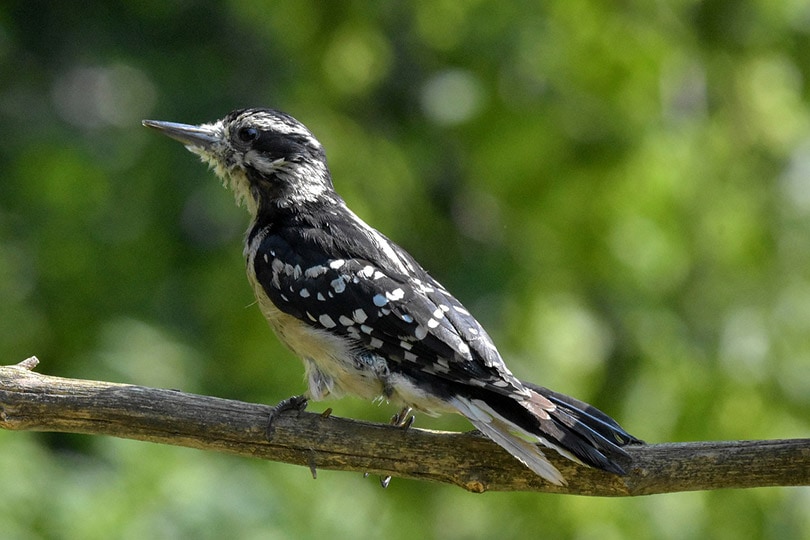10 Species of Woodpeckers in New Mexico (with Pictures)
Last Updated on

In the southwestern region of the United States, New Mexico is home to many species of woodpeckers that can thrive in the dry, hot, and barren landscapes by taking cover amongst the small number of trees available.
If you’re stopping in the state or are already a longtime resident, we will show you 10 species of woodpeckers in New Mexico and their characteristics. Stay tuned for information about feeding and attracting them to your home.

The 10 Species of Woodpeckers in New Mexico
1. Acorn Woodpecker

| Scientific name: | Melanerpes formicivorus |
| Family: | Picidae |
| Endangerment: | Stable |
The Acorn Woodpecker is a species that primarily resides in the western portion of New Mexico that borders Arizona, and they nest in oakwood forests. Physically, these woodpeckers will have a red-tipped head and black coat. They love to nest inside trees and collect as many acorns as possible for food storage. However, they are omnivorous and may eat insects as well, such as ants. Be cautious when attracting them to your yard, as they tend to burrow into wooden houses.
2. Red-Headed Woodpecker

| Scientific name: | Melanerpes erythrocephalus |
| Family: | Picidae |
| Endangerment: | In decline |
In a few scattered spots in eastern New Mexico, you can find this species digging crevices for their food supply, which consists of berries, acorns, seeds, nuts, and even small insects like ants or grasshoppers. In addition to that, they love catching flies for a quick snack.
These birds have a vibrant, saturated head that is covered in crimson, while their body area is a mix of monotone colors. Their habitat is mainly in woodland swamps or farms, but the population is, unfortunately, in decline.
3. Northern Flicker

| Scientific name: | Colaptes auratus |
| Family: | Picidae |
| Endangerment: | Stable |
Throughout the US, Canada, and Mexico, the Northern Flicker is a common sight, and the majority that live in New Mexico are year-round residents. Their diet is made mostly of ants because they forage on the ground rather than in trees or other standing objects. Still, they do live inside of trees in woodlands for shelter. The color of the Northern Flicker varies depending on which side of the country you are in, but those on the west side of the state will see the reddish hues of their complexion.
4. Downy Woodpecker

| Scientific name: | Dryobates pubescens |
| Family: | Picidae |
| Endangerment: | Stable |
Although Downy Woodpeckers are found throughout the United States and Canada, their limit is just below central New Mexico. You’ll have better luck in the northwest part of the state to find them, where they forage for insects that crawl upon tree canopies.
Visually, they’ve got a set of alternating black and white sections that mask their head. They have a small, pinkish-orange top as well as checkered-style wings. Be careful not to mix them up with Hairy Woodpeckers, as they look nearly identical.
5. Lewis’s Woodpecker

| Scientific name: | Melanerpes lewis |
| Family: | Picidae |
| Endangerment: | Unstable |
With pinkish-red highlights around the eyes and bottom body portion, Lewis’s Woodpecker is a bird that has wings that look much like a crow’s. Instead of foraging in the bark of trees or into the ground, this species dominates the air by catching flies or grasshoppers. They do nest in tree cavities, but their population is low due to habitat loss. The best time to try and find them is during the months ranging from April to July.
6. American Three-Toed Woodpecker

| Scientific name: | Picoides dorsalis |
| Family: | Picidae |
| Endangerment: | Stable |
The American Three-Toed Woodpecker is a rarity in New Mexico and can only be found in the central area of the state, as well as along its border with Colorado. Unlike many red-topped birds on this list, the males of this species display a yellow color with black wings and a whitish-gray body. They love dense forests that are strewn with bug larvae behind the layers of bark. They nest in the cavities of trees to shield their young and can defend them with their strong beaks.
7. Williamson’s Sapsucker

| Scientific name: | Sphyrapicus thyroideus |
| Family: | Picidae |
| Endangerment: | Stable |
Both the central and eastern regions of New Mexico are home to Williamson’s Sapsucker. The most obvious identification trouble you might have is to try and differentiate males from females. They look as if they are an entirely different bird species. The male has a yellow underbelly, red throat, and black coat. The female looks striped with a mix of colors on the wings and back portion with a brownish head.
8. Hairy Woodpecker

| Scientific name: | Dryobates villosus |
| Family: | Picidae |
| Endangerment: | Stable |
As we mentioned with the Downy Woodpecker, these species can often be mistaken for each other. The Hairy Woodpecker is a bit larger and lives across the entirety of the North American continent, spanning to central America. In New Mexico, the only place you might have trouble finding them is near the border of Texas.
You have likely seen them before, as they are one of the most common types of woodpeckers and have lived in one place for most of their lives. Hairy Woodpeckers have a distinct pinkish-red head and white-spotted wings. Similar to other woodpeckers, they love to consume insects and forage trees.
9. Gila Woodpecker

| Scientific name: | Melanerpes uropygialis |
| Family: | Picidae |
| Endangerment: | Stable |
If you travel to the southwestern corner of the state where Mexico, Arizona, and New Mexico collide, you may be able to witness a Gila Woodpecker. These birds have a gorgeous display of checkerboard wings, as well as a golden body and pinkish-red tip on their heads. They primarily feed on insects like ants and grasshoppers, which they store inside of the cacti that they also eat fruits from. Their desert habitat keeps them in the same area year-round.
10. Arizona Woodpecker

| Scientific name: | Dryobates arizonae |
| Family: | Picidae |
| Endangerment: | Unstable |
Though the name suggests that this species resides in Arizona, they cover most of their habitual area in Mexico. You will only be able to see them in New Mexico if you visit a minuscule region of the southwestern edge of the state. Males boast a saturated red crest, whereas females have a continuous brown color on their bodies. The Arizona Woodpecker is a bird that enjoys feeding on ants and living in woodland forests.

In Conclusion
New Mexico contains striking woodpecker species that often exhibit beautiful colors of red, black, orange, yellow, and white. This list was in no particular order, as we all have our preferences. If you’re hoping to attract or sightsee local woodpeckers while living or visiting in New Mexico, we hope this guided you to some of the best birds in the state. Always remember to keep a safe observational distance and have fun!
See Also: 14 Types of Hummingbirds in New Mexico (With Pictures)
Featured Image Credit: JackBulmer, Pixabay
About the Author Robert Sparks
Robert’s obsession with all things optical started early in life, when his optician father would bring home prototypes for Robert to play with. Nowadays, Robert is dedicated to helping others find the right optics for their needs. His hobbies include astronomy, astrophysics, and model building. Originally from Newark, NJ, he resides in Santa Fe, New Mexico, where the nighttime skies are filled with glittering stars.
Related Articles:
Monocular vs Telescope: Differences Explained (With Pictures)
10 Types of Hummingbirds in Arkansas (With Pictures)
8 Types of Hummingbirds in Nebraska (With Pictures)
5 Types of Hummingbirds in Idaho (With Pictures)
3 Types of Hummingbirds in Mississippi (With Pictures)
8 Types of Hummingbirds in Kansas (With Pictures)
5 Types of Hummingbirds in West Virginia (With Pictures)
5 Types of Hummingbirds in Ohio (With Pictures)
